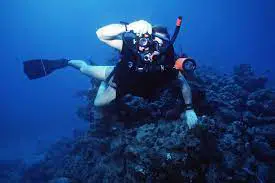Introduction
Quick Navigation
There are so many lovely things and memories to create underwater, and what better way to do that than photography. It is the perfect way to show everyone else who didn’t have the opportunity to see what the underwater world looks like. Scuba Photography is incredible, and it isn’t restricted to any skill level.
Ideally, Diving requires your utmost attention, i.e., no distraction, alongside maintaining better buoyancy control and anything related to your safety and comfort. However, it would help if you didn’t miss out on incredible moments because you may never get the chance again. Therefore, you must get your hands on underwater cameras and practice using them without losing concentration.
Read on the Night Diving Guide for all Scuba Divers.
What Gear Do You Need for Scuba Photography?
Whether you are diving during the daytime or at nighttime, having the right gear will do you a lot of good. Generally, diving gear is customizable so that you pick essentials and every other thing you need. One of the things that will come in useful is a camera for underwater photography.
Camera
People’s knowledge of cameras varies; some people are familiar with the use and the shots they aim to take, while others aren’t. Regardless, the three types of underwater cameras you will find useful are Video Recorder (GoPro), Advanced DSLR (with waterproof casing), and Compact Camera. Your choice of any of these action cameras depends on personal preference and how familiar you are with them.
Camera Housing
Apart from these cameras, an important consideration to use these devices to full potential is the housing. It is somewhat a vital piece of the underwater photography gear, as it protects the camera from water (i.e., waterproof) and against depths.
Strobe or Flash
Another important piece in the gear is a strobe or flash. It is the Aartificiallight source for your camera, as there is a limited light supply coming from the sun in the water. This piece of gear improves image color capture and contrast to achieve professional and detailed pictures.
What are the Tips You Need for Lighting Underwater?
Having a camera and other vital pieces of underwater photography gear is one thing; knowing how to handle them is another. The most significant aspect of this type of photography is lighting because only with that will you get the desired result you aim for.
If you would like to know how to take pictures underwater with the correct lighting, the following tips should help.
Distance and Color Don’t Work
The basic concept of lighting is that: the more the distance, the poorer the color quality of pictures. In essence, distance has a way of fading color; therefore, you might need to compensate for that distance with a light source. So, if you have a depth and horizontal distance between you and an object, use your light source (flash) to compensate for the distance for better image quality.
Rely on Sunlight
It is no news that the deeper you go underwater, the lesser the amount of sunlight that gets underwater. Nevertheless, whatever you get from natural sunlight plays a role in lighting for enhanced image quality. This natural sunlight is called ambient sunlight, and it is suitable for large scenes.
Get a Good Flash or Strobe Light
While you rely on sunlight for photography, you need a strobe light to make things even better. A strobe light is known to prevent backscatter and blurry images because ambient light causes slower shutter speed. Thus, if you want your pictures to be as clear as day, having a strobe would help.
Additionally, it is important thing to focus on different aspects of an object or marine life. Therefore, trying out different strobe angles for detailed and professional pictures is advised.
Make Adjustments
One inevitable thing with photography (especially scuba photography) is that you never stop adjusting to get clear and well-colored images. Underwater, you need flashes and strobe lights; however, their excessive use can cause a hotspot with an area being over-illuminated than other parts. Sometimes, the situation could be caused by reflective materials or marine life like silverfish, white rocks, etc.
If that happens, what you need to do is adjust the white balance to your light source for even illumination. By the time you capture the object, you have an even coloring in your photo.
Work on Your Distance
As mentioned earlier above, distance and color don’t go hand-in-hand – likewise, focus. If you can try, get a close-up of your object by working on your distance. You can switch your camera mode to Macro Mode since it guarantees high-quality shots between you and your subject from 2 inches and 2 feet away.
Besides, the clearer the picture, the more the contrast.
How Do You Capture Colors Underwater?
Not everything you see in a photo is always as it seems underwater. Colors fade underwater with increasing depth; however, filters compensate for that, making the object/subject look vibrant. Nevertheless, there are good ways to capture colors – macro mode, wide-angle mode, and lighting angle.
In macro mode, using a flashlight when there is enough ambient light is not advisable. Also, you only have to capture subjects within 6 inches from you for red and orange colors.
Capturing images with colors is possible in shallow waters with the wide-angle mode. It makes use of ambient light and also filters if need be.
Lastly, your lighting angle, i.e., a good position, can help you capture colors underwater.
Conclusion
Underwater photography has got better over the years with the invention of better-quality cameras and other gear for great image capture. If you didn’t know beforehand, what to take on your next scuba diving adventure, here is one thing you can add to your gear. In conclusion, scuba photography is open to all divers of all age groups and skill levels.

